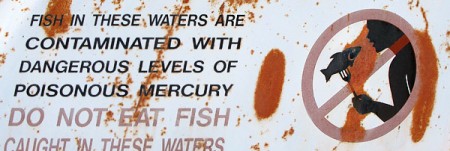Monday June 11, 2012
 Contamination of fish is becoming a growing concern for many recreational and commercial fishermen. Recently, results from the first statewide study of contaminants in fish caught off the California coast revealed high levels of methylmercury, a toxin that damages the central nervous system, in more than one-third of the locations sampled. High levels of mercury, greater than 0.44 parts-per-million (ppm), were detected in fish tissue at 25 of the 68 locations sampled (SWAMP 2012). However, location was not the key driver, rather the main factor linked to contamination level was the type of fish. Older, predatory fish such as sharks and some forms of rockfish were found to have the highest levels of mercury. The North Coast (from the Oregon border to Point Reyes) had the highest percentage of locations with at least one species above 0.44 ppm of mercury (11 out of 15, or 73%). The Central Coast (from Point Reyes south to Point Conception) had the second highest percentage (10 of 26, or 38%) while the South Coast (from Point Conception south to the Mexican border) had the lowest percentage of locations above 0.44 ppm of mercury (4 of 27, or 15%) (SWAMP 2012). All of the species with high concentrations of mercury were high-level predators, which can be explained through bioaccumulation of mercury up the food chain.
Contamination of fish is becoming a growing concern for many recreational and commercial fishermen. Recently, results from the first statewide study of contaminants in fish caught off the California coast revealed high levels of methylmercury, a toxin that damages the central nervous system, in more than one-third of the locations sampled. High levels of mercury, greater than 0.44 parts-per-million (ppm), were detected in fish tissue at 25 of the 68 locations sampled (SWAMP 2012). However, location was not the key driver, rather the main factor linked to contamination level was the type of fish. Older, predatory fish such as sharks and some forms of rockfish were found to have the highest levels of mercury. The North Coast (from the Oregon border to Point Reyes) had the highest percentage of locations with at least one species above 0.44 ppm of mercury (11 out of 15, or 73%). The Central Coast (from Point Reyes south to Point Conception) had the second highest percentage (10 of 26, or 38%) while the South Coast (from Point Conception south to the Mexican border) had the lowest percentage of locations above 0.44 ppm of mercury (4 of 27, or 15%) (SWAMP 2012). All of the species with high concentrations of mercury were high-level predators, which can be explained through bioaccumulation of mercury up the food chain.
Mercury is released from ores, minerals and fossil fuels into the atmosphere where it can circulate through out the world and accumulate in living organisms in the water and on land. These releases are through natural events or during human activities. Among the largest sources of mercury emissions in the U.S. are coal power plants and mining operations (especially gold mining). A potentially growing source of mercury is disposable products such as compact fluorescent light bulbs and electronic devices, which both contain mercury. The mercury eventually leaks into the atmosphere when the products are crushed in a landfill.
Polychlorinated biphenyls (PCBs) were the only other contaminant detected in fish tissues at concentrations that pose potential health concerns to consumers of fish caught in coastal California waters. Far fewer locations fell into the high contamination category for PCBs (5 of 68, or 7%) than for methylmercury. PCBs have been banned in North America since the 1970s when they were widely used as insulation in electrical equipment, but they are still showing up in coastal California waters. PCBs are insoluble in water and not readily excreted by marine organisms; as a result they are often passed up the food chain. The results from the statewide survey will be used to prioritize coastal areas that are in need of cleanup or identify areas that need continued monitoring.
The Southern California coast may have had the lowest percentage of locations with high contamination of mercury, but a new study has recently found elevated levels of radioactivity in blue fin tuna off the coast of San Diego. This radiation is directly linked to the nuclear power plant disaster in Japan following the March 2011 earthquake. Blue fin tuna are a highly migratory fish traveling across the Pacific Ocean from Japan all the way to Southern California, but researchers were shocked to learn the fish were not able to flush out all of the contamination from their system during their journey across the ocean. This summer, researchers plan to repeat the study using a larger sample size to determine just how radioactivity may affect tuna populations. Scientists are also interested in tracking other migratory species for contamination such as sharks, sea turtles and seabirds.
